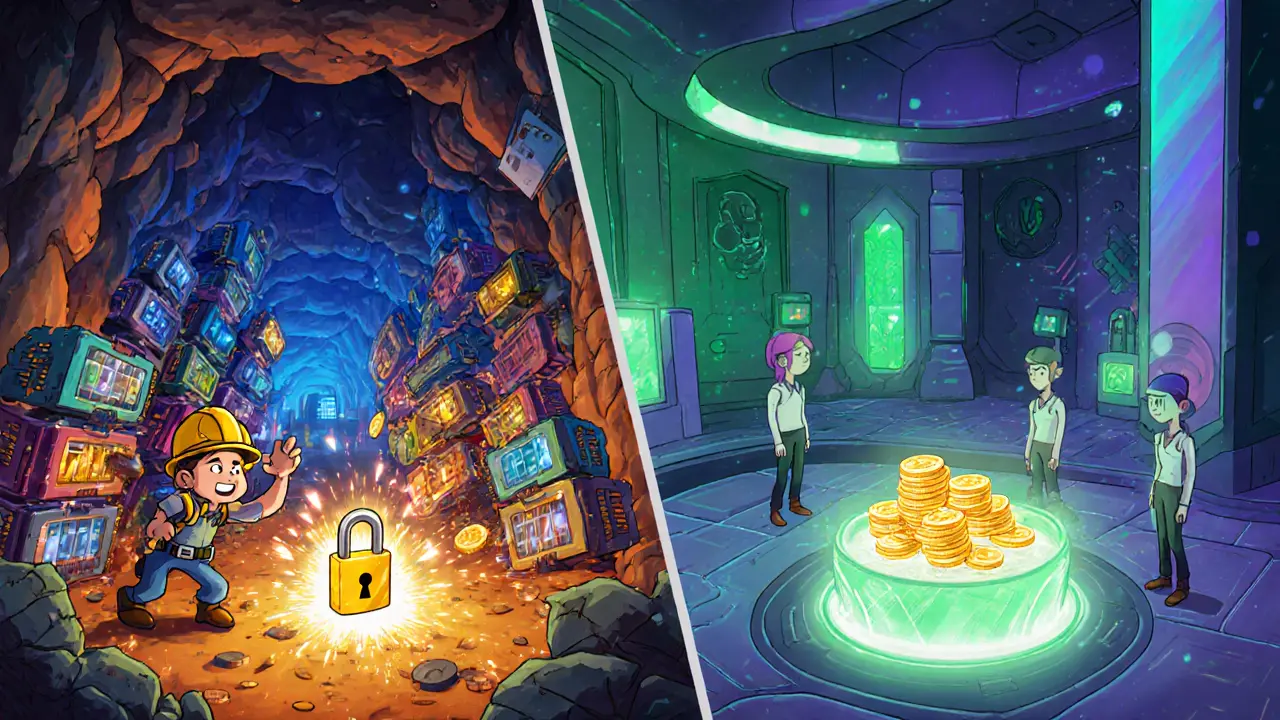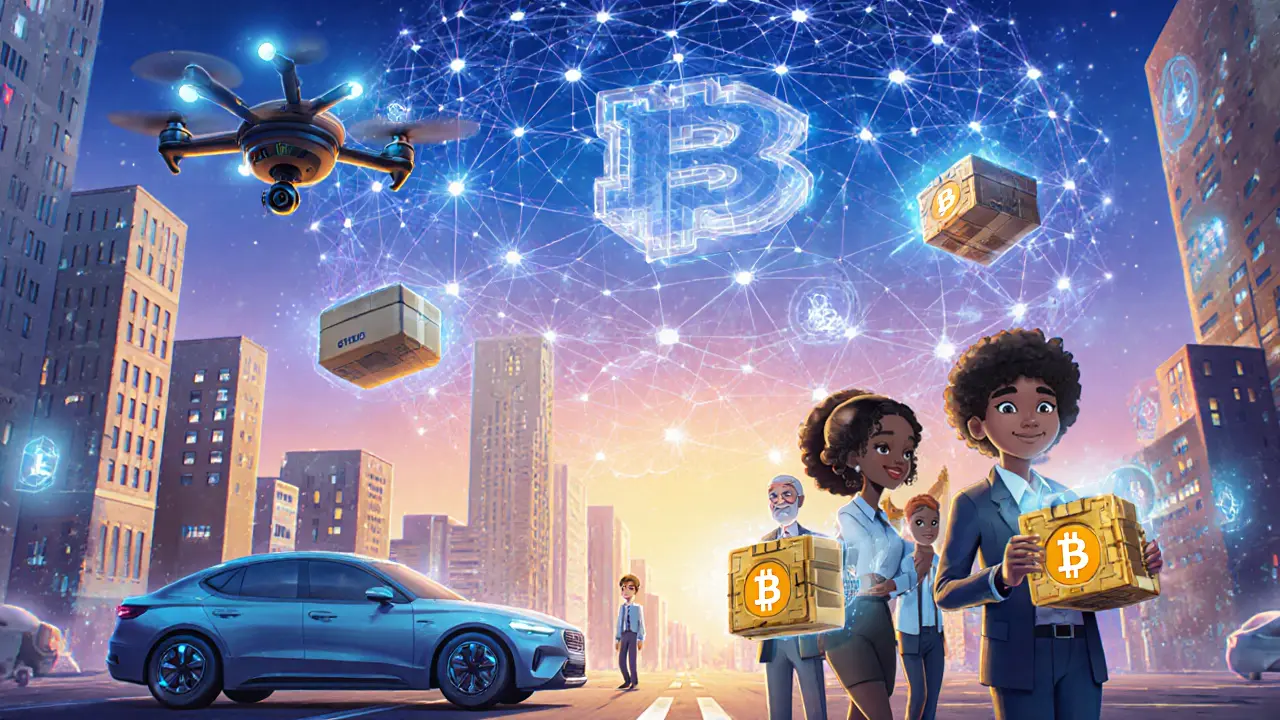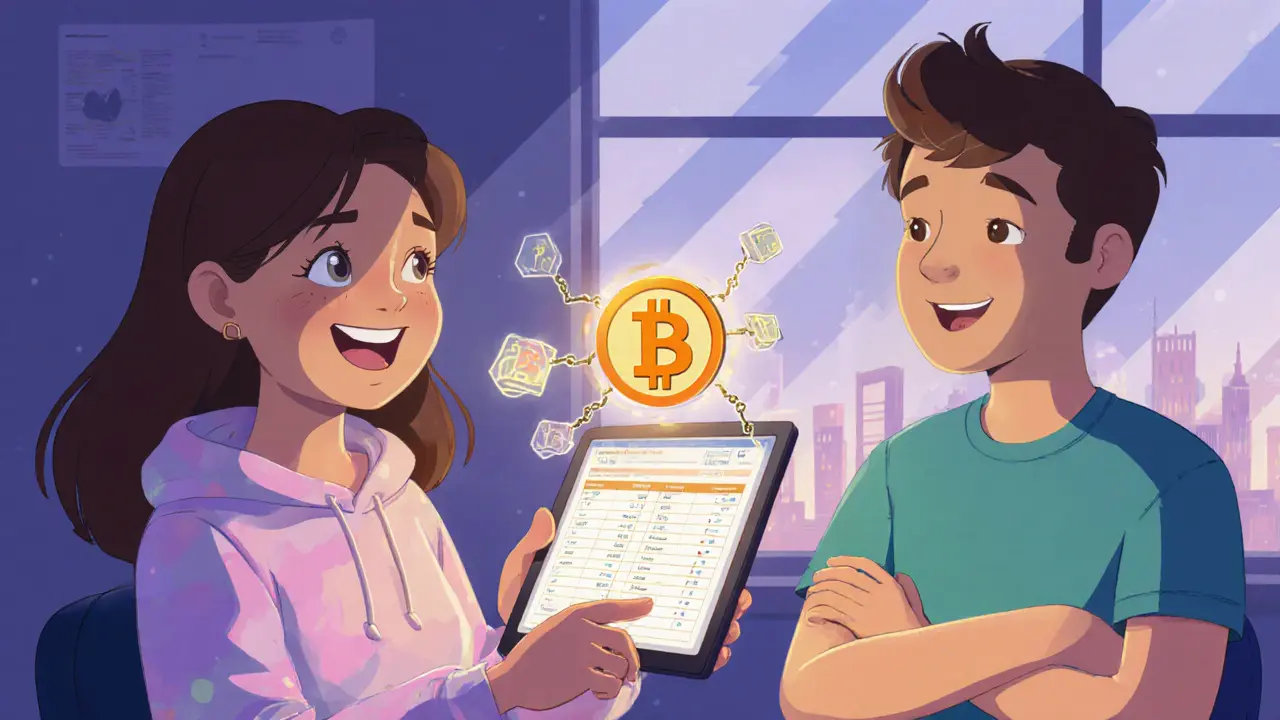Cryptocurrency Transaction Simulator
Enter details and click 'Process Transaction' to see the steps.
Proof of Work (PoW)
Miners compete to solve complex mathematical puzzles. The first to solve it gets to add a new block to the blockchain and earns rewards.
Energy-intensive but highly secure due to computational cost.
Proof of Stake (PoS)
Validators are chosen based on the number of coins they hold and are willing to "stake" as collateral.
More energy-efficient and environmentally friendly.
Ever wondered how you can send money across the globe without a bank, or why people talk about “digital gold” and “tokens”? The answer lies in cryptocurrency, a system that replaces traditional ledgers with clever math and a network of computers that all agree on who owns what. Below you’ll find a plain‑language walk‑through that strips away the jargon and shows exactly what’s happening behind the scenes.
Quick Takeaways
- Cryptocurrency is digital money that lives on a public ledger called a blockchain.
- Transactions are verified by a network of nodes, not by banks.
- Two main ways to reach consensus: Proof of Work (mining) and Proof of Stake.
- Your keys - not a bank account - give you control over your funds.
- Use cases range from payments to smart contracts and supply‑chain tracking.
What Is Cryptocurrency?
Cryptocurrency is a digital currency that uses cryptographic techniques to secure transactions and control the creation of new units. It operates on a peer‑to‑peer network, meaning anyone with an internet connection can send or receive coins without needing a central authority.
The most famous example is Bitcoin, launched in 2009. Bitcoin proved that a decentralized digital cash system could work, and it sparked the creation of thousands of other coins and tokens.
How Blockchain Powers It
Blockchain is an open, distributed ledger that records every transaction in a series of linked blocks. Each block contains a batch of transactions, a timestamp, and a cryptographic hash of the previous block, forming an immutable chain.
This structure solves the “double‑spending” problem that plagued earlier digital money attempts. Because every node (computer) in the network holds a copy of the ledger, no single party can alter past records without the entire network noticing.
From Alice to Bob: A Transaction Walk‑Through
Imagine Alice wants to send 0.5BTC to Bob. She opens her Wallet software that stores private keys and creates signed transaction messages
and initiates a transfer. The wallet crafts a message that includes:- Alice’s public address (where the funds are coming from)
- Bob’s public address (where the funds are going)
- The amount to move
- A timestamp
- A digital signature generated with Alice’s private key
She broadcasts this message to the network. Nodes see the pending transaction, group it with others, and hand it off to a miner (or validator) for processing.

Mining, Validation, and Consensus
Miner a participant that solves a cryptographic puzzle to add a new block to the blockchain
in Proof‑of‑Work systems. Miners race to find a hash that meets the network’s difficulty target. The first to succeed publishes the solution, and other nodes verify it. If the block is valid, it’s appended, confirming Alice’s payment.Not all cryptocurrencies use mining. Proof of Stake chooses validators based on the amount of coins they lock up as collateral
instead of raw computing power. This method reduces energy consumption dramatically and still secures the network because validators risk losing their stake if they approve fraudulent transactions.| Aspect | Proof of Work (PoW) | Proof of Stake (PoS) |
|---|---|---|
| How validators are chosen | First miner to solve a cryptographic puzzle | Chosen proportionally to the amount of stake held |
| Energy use | High - requires powerful hardware | Low - relies on existing holdings |
| Reward type | Newly minted coins + transaction fees | Transaction fees + a portion of newly minted coins |
| Security model | Costly to attack due to hardware expense | Attackers must own a large share of the total stake |
| Examples | Bitcoin, Litecoin | Ethereum (post‑merge), Cardano |
Nodes - The Backbone of the Network
Node any computer that runs the cryptocurrency software and maintains a copy of the blockchain
. Nodes can be full‑nodes, which store the entire ledger, or lightweight nodes that rely on others for data. By constantly sharing and validating blocks, nodes keep the system synchronized and resistant to tampering.Tokens, Coins, and Smart Contracts
While “coin” often refers to native currencies like Bitcoin, many platforms issue Token a digital asset built on top of an existing blockchain
. Tokens can represent anything from a utility within a dApp to a share of real‑world assets. The rise of Smart Contract self‑executing code that runs when predefined conditions are met on platforms like Ethereum has expanded crypto use cases far beyond simple payments-think automated escrow, decentralized finance (DeFi) lending, or supply‑chain tracking.Risks, Volatility, and Practical Tips
Cryptocurrencies are notoriously volatile. Prices can swing double‑digit percentages in a single day, driven by news, regulatory shifts, or large‑holder moves. Security rests on private keys; lose the key, lose the funds. Phishing attacks, ransomware, and exchange hacks remain real threats.
If you’re just starting:
- Pick a reputable exchange (e.g., Coinbase, Kraken) to buy a well‑established coin like Bitcoin or Ethereum.
- Transfer the coins to a personal wallet-hardware wallets (Ledger, Trezor) offer the best protection.
- Back up your seed phrase offline and never share it.
- Start with a small amount you can afford to lose while you learn the ropes.
Where Crypto Is Headed
Beyond payments, blockchain is infiltrating supply‑chain management, identity verification, and even voting systems. Regulatory frameworks are evolving worldwide, aiming to balance innovation with consumer protection. As the technology matures, we’re likely to see more integration with traditional finance-think tokenized stocks or bond trading on blockchain platforms.

Frequently Asked Questions
What exactly is a blockchain?
A blockchain is a distributed database where each block contains a list of transactions and a unique hash linking it to the previous block. Because every participant holds a copy, altering a past block would require changing the entire chain across the network, which is practically impossible.
Do I need to mine cryptocurrency to own it?
No. Most people buy crypto on exchanges or receive it as payment. Mining is energy‑intensive and competitive, and only a small fraction of users actually run mining hardware.
What’s the difference between a coin and a token?
A coin runs on its own blockchain (e.g., Bitcoin, Ethereum). A token is built on top of another blockchain and usually serves a specific function within an app or ecosystem.
Is cryptocurrency illegal?
Legality varies by jurisdiction. Most countries allow owning and transacting crypto but impose tax, anti‑money‑laundering (AML), and reporting requirements.
How can I keep my crypto safe?
Use a hardware wallet, store the seed phrase offline, enable two‑factor authentication on exchanges, and never share your private keys.


Taylor Gibbs
October 7, 2024 AT 20:17Welcome to the crypto chat fam, we all learn together!
Cynthia Rice
October 15, 2024 AT 21:26The blockchain whispers truths only the brave hear.
Tyrone Tubero
October 23, 2024 AT 22:34Yo, if u think crypto is just a fad, u haven't even scratched the surface of decentralized awesomeness!
Alex Gatti
October 31, 2024 AT 22:43So cool how a network of strangers can agree on stuff without a boss it’s like digital democracy right?
John Corey Turner
November 8, 2024 AT 23:51When you first hear about cryptocurrency, the whole concept can feel like stepping into a sci‑fi novel.
But at its core, it is just a clever way to keep a public ledger without trusting a single authority.
Every transaction is a tiny piece of data that gets bundled into a block.
That block is then linked to the previous one by a cryptographic hash, forming a chain that is practically immutable.
Because each node in the network holds a copy of this chain, changing a past block would require rewriting the entire history on every single computer.
This is what gives blockchain its security and why double‑spending becomes virtually impossible.
Now, the process of adding a new block depends on the consensus mechanism the network chooses.
In Proof of Work, miners compete to solve a puzzle that is deliberately hard, expending computational power and electricity.
The first miner to find a solution broadcasts the new block, and the rest of the network quickly verifies it.
In Proof of Stake, the right to create the next block is assigned to validators who lock up a portion of their holdings as collateral.
If a validator tries to cheat, they stand to lose that stake, which aligns incentives nicely.
Both methods aim to achieve the same goal: agreement among participants on the order and validity of transactions.
Your wallet plays a crucial role by storing private keys that prove ownership without ever revealing the keys themselves.
When you sign a transaction, you are essentially attaching a mathematical proof that only you could have produced.
The network then checks that proof, ensures you have enough balance, and, once consensus is reached, the transaction becomes part of the immutable record.
All of this happens in a matter of minutes, sometimes seconds, depending on the blockchain’s design.
Katherine Sparks
November 17, 2024 AT 01:00I appreciate the thoroughness of this guide; it provides a solid foundation for newcomers. Please remember to keep your seed phrase offline. :)
Kimberly Kempken
November 25, 2024 AT 02:08Honestly, this whole hype is just a digital Ponzi scheme masquerading as innovation.
Eva Lee
December 3, 2024 AT 03:17From a systems architecture perspective, the transaction lifecycle encapsulates multiple layers of protocol abstraction, which you seem to have oversimplified.
stephanie lauman
December 11, 2024 AT 04:26One must consider the hidden agenda of the elite who manipulate blockchain narratives to consolidate power.
Twinkle Shop
December 19, 2024 AT 05:34The evolution of decentralized finance represents a paradigm shift that extends far beyond mere speculative trading. By leveraging immutable ledgers, developers can construct trustless protocols for lending, borrowing, and yield generation without intermediaries. This architectural re‑engineering reduces friction, lowers costs, and democratizes access to financial services that were previously gated. Moreover, interoperable standards such as ERC‑20 and ERC‑721 facilitate seamless asset transfers across heterogeneous ecosystems, fostering a vibrant composability layer. As the ecosystem matures, regulatory frameworks will inevitably converge, but the underlying technical robustness remains a catalyst for innovation.
Jenise Williams-Green
December 27, 2024 AT 06:43We cannot stand by as the decentralized promise is twisted into a tool for greed!
Kortney Williams
January 4, 2025 AT 07:51I agree, adding a few resources could help beginners navigate the maze more confidently.
Promise Usoh
January 12, 2025 AT 09:00The theoretical underpinnings of distributed consensus are well‑documented; however, practical implementations oftentimes deviate.
Shaian Rawlins
January 20, 2025 AT 10:08Seeing the ledger grow with each block is like watching a tapestry being woven in real time. Every participant contributes a thread, and the pattern only emerges when enough of us cooperate. It’s fascinating how cryptographic hashes tie everything together, ensuring that any tampering would be instantly visible. Remember, the private key is your passport; guard it fiercely. Start small, experiment with testnets, and you’ll soon feel at home in this decentralized landscape.
Miranda Co
January 28, 2025 AT 11:17Don’t be fooled by shiny charts; the market is a beast that devours the reckless.
mukesh chy
February 5, 2025 AT 12:25Oh sure, because the internet never had scams before crypto.
Marc Addington
February 13, 2025 AT 13:34Patriots should keep their wealth in national currencies, not foreign digital tokens.
Amal Al.
February 21, 2025 AT 14:42Please, always verify the smart contract address before sending any funds; it is a critical security step!
Natalie Rawley
March 1, 2025 AT 15:51I’m telling you, the crypto world is the most exciting saga ever!
Scott McReynolds
March 9, 2025 AT 17:00Exploring the philosophical implications of trustless systems can broaden our perspective on societal organization.
When we remove intermediaries, we also remove points of failure, which challenges traditional notions of authority.
Yet, this decentralization introduces new responsibilities on individuals to safeguard their keys and understand protocol rules.
The balance between autonomy and security becomes a central theme in modern digital economics.
By embracing these concepts, we participate in an experiment that could reshape how value is transferred across borders.
It’s an exciting frontier that rewards curiosity and continuous learning.
Greer Pitts
March 17, 2025 AT 18:08Hey everyone, glad to see this discussion buzzing!
Lurline Wiese
March 25, 2025 AT 19:17Yo, crypto is like a rollercoaster that never stops!